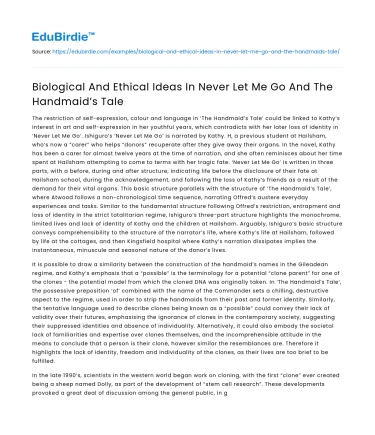The restriction of self-expression, colour and language in ‘The Handmaid’s Tale’ could be linked to Kathy’s interest in art and self-expression in her youthful years, which contradicts with her later loss of identity in ‘Never Let Me Go’. Ishiguro’s ‘Never Let Me Go’ is narrated by Kathy. H, a previous student at Hailsham, who’s now a “carer” who helps “donors” recuperate after they give away their organs. In the novel, Kathy has been a carer for almost twelve years at the time of narration, and she often reminisces about her time spent at Hailsham attempting to come to terms with her tragic fate. ‘Never Let Me Go’ is written in three parts, with a before, during and after structure, indicating life before the disclosure of their fate at Hailsham school, during the acknowledgement, and following the loss of Kathy’s friends as a result of the demand for their vital organs. This basic structure parallels with the structure of ‘The Handmaid’s Tale’, where Atwood follows a non-chronological time sequence, narrating Offred’s austere everyday experiences and tasks. Similar to the fundamental structure following Offred’s restriction, entrapment and loss of identity in the strict totalitarian regime, Ishiguro’s three-part structure highlights the monochrome, limited lives and lack of identity of Kathy and the children at Hailsham. Arguably, Ishiguro’s basic structure conveys comprehensibility to the structure of the narrator’s life, where Kathy’s life at Hailsham, followed by life at the cottages, and then Kingsfield hospital where Kathy’s narration dissipates implies the instantaneous, minuscule and seasonal nature of the donor’s lives.
It is possible to draw a similarity between the construction of the handmaid’s names in the Gileadean regime, and Kathy’s emphasis that a “possible” is the terminology for a potential “clone parent” for one of the clones - the potential model from which the cloned DNA was originally taken. In ‘The Handmaid’s Tale’, the possessive preposition ‘of’ combined with the name of the Commander sets a chilling, destructive aspect to the regime, used in order to strip the handmaids from their past and former identity. Similarly, the tentative language used to describe clones being known as a “possible” could convey their lack of validity over their futures, emphasising the ignorance of clones in the contemporary society, suggesting their suppressed identities and absence of individuality. Alternatively, it could also embody the societal lack of familiarities and expertise over clones themselves, and the incomprehensible attitude in the means to conclude that a person is their clone, however similar the resemblances are. Therefore it highlights the lack of identity, freedom and individuality of the clones, as their lives are too brief to be fulfilled.
Save your time!
We can take care of your essay
- Proper editing and formatting
- Free revision, title page, and bibliography
- Flexible prices and money-back guarantee
In the late 1990’s, scientists in the western world began work on cloning, with the first “clone” ever created being a sheep named Dolly, as part of the development of “stem cell research”. These developments provoked a great deal of discussion among the general public, in government, and at universities regarding humankind’s moral obligation to cellular life. ‘Never Let Me Go’ presumes a more complex and widespread system of organ-farming, with the clones being human, but with lives existing solely to create and provide organs for “real” humans. Ishiguro allows these biological and ethical ideas to absorb in the background, while a human plot of love, loss, and maturation occurs in the front line.






 Stuck on your essay?
Stuck on your essay?

